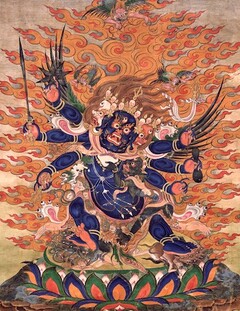Daily Yamāntaka Practice
༄༅། །འཇམ་དཔལ་གཤིན་རྗེའི་རྒྱུན་ཁྱེར་བཞུགས།
A Daily Practice of Mañjuśrī Yamāntaka
by Jamyang Khyentse Chökyi Lodrö
སྐྱབས་སེམས་སྔོན་དུ་འགྲོ་བས།
With refuge and bodhicitta as a preliminary, recite the following:
ཨྱཻ། ཨེ་ཉིད་སྟོང་པ་ཆོས་འབྱུང་སྟེ། །
ayai, é nyi tongpa chöjung té
Ayai! From the dharmadhātu, the empty space of É as such,
མ་སྐྱེས་འགགས་པ་མེད་པ་ལས། །
makyé gakpa mepa lé
Which is unborn and does not cease,
རང་བཞིན་གནས་པ་དྲན་པར་བྱ། །
rangzhin nepa drenpar ja
I bring to mind that which is naturally present:
ཨཻ་ཡི་ཕོ་བྲང་ཆེན་པོའི་ནང་། །
ai yi podrang chenpö nang
Within the great palace of Ai,
རྒྱུ་དང་རྐྱེན་ལས་མ་བསྐྱེད་པར། །
gyu dang kyen lé makyepar
Not created through causes and conditions,
ཀླུ་གཉན་ས་བདག་རུ་ཏྲ་དང་། །
lunyen sadak rudra dang
Mañjuśrī arises out of awareness, like a fish leaping from water,
མ་ཧེ་ཉི་ཟླ་པདྨའི་སྟེང་། །
mahé nyida pemé teng
In a form of overwhelming splendour,
རིག་པ་ཆུ་ལས་ཉ་འཕར་ཚུལ། །
rigpa chu lé nya par tsul
And standing upon nāgas, nyen, earth lords, rudras,
འཇམ་དཔལ་ཕྱག་རྒྱ་ཟིལ་གྱིས་གནོན། །
jampal chakgya zil gyi nön
Buffaloes, sun, moon and lotus.
དབུ་གསུམ་ཕྱག་དྲུག་ཞབས་བཞི་བསྒྲད། །
u sum chak druk zhab zhi dré
He has three faces, six arms and four striding feet,
གཡས་དཀར་གཡོན་དམར་དབུས་མཐིང་ཞལ། །
yé kar yön mar ü ting zhal
The right face is white, the left face red, and the central face blue.
འཁོར་ལོ་རལ་གྲི་རྡོ་རྗེ་གཡས། །
khorlo raldri dorjé yé
In his right hands he holds a wheel, sword and vajra;
བེ་ཅོན་གཏུན་ཤིང་སྡིག་མཛུབ་གཡོན། །
bechön tün shing dik dzub yön
With his left hands he holds a club and wooden pestle and makes a threatening mudrā.
རིགས་ལྔའི་ཁྲོ་བོས་དབུ་ལ་བརྒྱན། །
rik ngé trowö u la gyen
The wrathful ones of the five families adorn his crown
དཔལ་གྱི་ཆས་རྫོགས་དུར་ཁྲོད་བརྒྱན། །
pal gyi ché dzok durtrö gyen
And he has all the glorious attributes and ornaments of the charnel ground.
ཡུམ་ནི་གཉིས་མེད་ཆོས་ཀྱི་དབྱིངས། །
yum ni nyimé chö kyi ying
His consort, indivisible within the dharmadhātu,
མཐིང་ནག་ཙིཏྟ་བྷན་དམར་སྟོབས། །
tingnak tsitta bhen mar tob
Is dark blue and proffers a heart and blood-filled skullcup.
སྤྲུལ་པ་རྒྱན་གྱི་ལྷ་བརྒྱད་དང་། །
trulpa gyen gyi lha gyé dang
As emanations, the eight deities of adornment
ཡེ་ཤེས་ཁྲོ་བོ་བཅུ་རྣམས་རྫོགས། །
yeshe trowo chu nam dzok
And the ten of wisdom wrath are all present.
སྤྲུལ་པའི་ཁྲོ་ཚོགས་དཔག་མེད་དང་། །
trulpé tro tsok pakmé dang
The deities emanate countless wrathful hosts
རྡོ་རྗེའི་ཚྭ་ཚྭ་རབ་ཏུ་འཕྲོ། །
dorjé tsatsa rabtu tro
And an effusion of vajra sparks.
སྣང་ལ་རང་བཞིན་མེད་པར་བསྒོམ། །
nang la rangzhin mepar gom
Visualize them all as appearing yet unreal.
ཐུགས་ཀར་ཉི་སྟེང་ཧཱུྃ་གི་མཐར། །
tukkar nyi teng hung gi tar
Upon a sun at Yamāntaka’s heart,
སྔགས་ཀྱི་ཕྲེང་བས་བསྐོར་བ་ལས། །
ngak kyi trengwé korwa lé
The mantra garland revolves around a syllable Hūṃ,
འོད་ཟེར་སྤྲོ་བསྡུས་དོན་གཉིས་བྱས། །
özer trodü dön nyi jé
Emitting and absorbing rays of light to fulfil the twofold aims.
སྣང་སྲིད་ཐམས་ཅད་དཔལ་ཆེན་པོའི། །
nangsi tamché palchenpö
All appearance and existence arises as the wisdom intent
ལྷ་སྔགས་དབྱེར་མེད་དགོངས་པར་ཤར། །
lha ngak yermé gongpar shar
In which deity and mantra of the Great Awesome One are indivisible.
ཨོཾ་ཨཱ་ཀྲོ་ཏེ་ཀ་ཡ་མཱནྟ་ཀ་ཧ་ན་མ་ཐ་བྷཉྫ་ཧཱུྃ་ཕཊ༔
om a trotéka yamantaka hana mata bhandza hung pé
oṃ āḥ krodhika yamāntaka hana matha bhañja hūṃ phaṭ
ཞེས་སྤྱི་བསྙེན་བཟླའོ། །
Recite this general approach mantra.
ཐུན་མཐར།
At the end of the session, conclude with:
ལྷར་སྣང་འོད་གསལ་དབྱིངས་སུ་ཐིམ། །
lhar nangö sal ying su tim
The deity’s appearance dissolves into the sphere of luminosity.
སླར་ཡང་ཟིལ་གནོན་སྐུ་རུ་ལྡང་། །
lar yang zilnön ku ru dang
Then arises once again in the form of overwhelming splendour.
བཛྲ་ཀཱ་ཝཱ་ཙི་རཀྵ་ཧཾ༔
benza ka wa tsi raksha hang
Vajra kāvāci rakṣa haṃ
དགེ་བ་འདི་ཡིས་མྱུར་དུ་བདག །
gewa di yi nyurdu dak
Through the positivity and merit of this, may I swiftly
འཇམ་དཔལ་ཁྲོ་བོ་འགྲུབ་གྱུར་ནས། །
jampal trowo drub gyur né
Attain the realization of wrathful Mañjuśrī, and thereby
འགྲོ་བ་གཅིག་ཀྱང་མ་ལུས་པ། །
drowa chik kyang malüpa
Every single sentient being
དེ་ཡི་ས་ལ་འགོད་པར་ཤོག །
dé yi sa la göpar shok
Reach his state of perfection too.
སོགས་བསྔོ་སྨོན་བྱའོ། །
Dedicate the merit and recite prayers of aspiration.
ཞེས་པའང་ཆོས་ཀྱི་བློ་གྲོས་པས་བྲིས་པའོ། །། །
This was written by Chökyi Lodrö.
| Translated by Adam Pearcey and Sean Price, with the generous support of the Khyentse Foundation and Tertön Sogyal Trust, 2021. This translation is dedicated to the memory of Hubert Decleer (1940–2021).
Source:
'Jam dbyangs chos kyi blo gros. “’jam dpal gshin rje’i rgyun khyer/“ in ’Jam dbyangs chos kyi blo gros kyi gsung ’bum. 12 vols. Bir: Khyentse Labrang, 2012. W1KG12986 Vol. 5: 145–146
Version: 1.0-20210902
